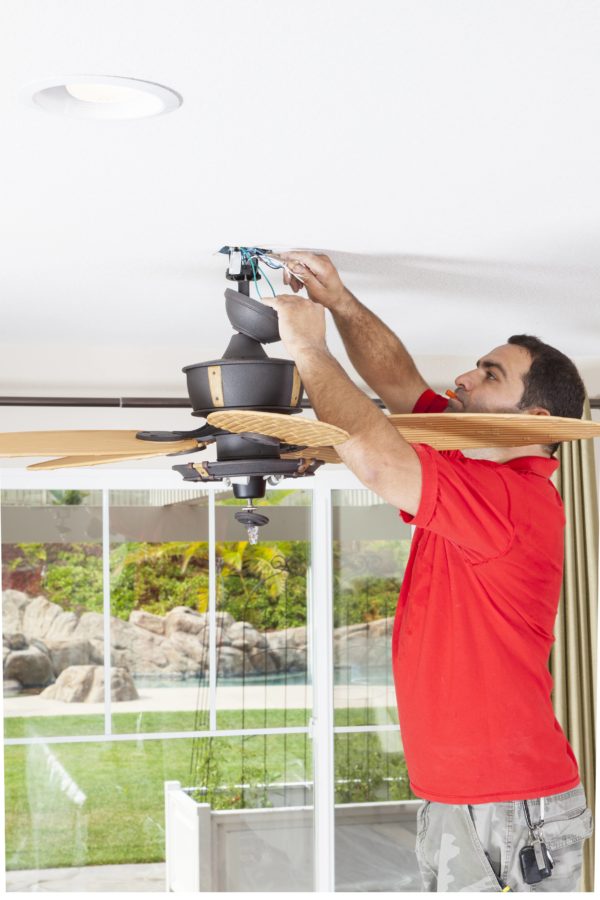Will Ceilings Fans Reduce Your Summertime Energy Bills?

When the hot summer weather comes back around, most homeowners dread the increase in their energy bills due to running their air conditioning systems. If you’re like most homeowners, you’re always looking for ways to keep your energy costs to a minimum. One of the best ways to do this is to install ceiling fans throughout your home.
Where Should You Install Ceiling Fans?
Installing ceiling fans in every single room of your home can be expensive and truly overkill. It’s best to stick to the most trafficked rooms of your home. For most homeowners, these will include your bedrooms, kitchen, living room, and home office. You want to invest in quality fans that will be able to move a substantial amount of air.
How to Set Your Ceiling Fans
While installing ceiling fans in your highly trafficked rooms is a great start, you’ll need to ensure that they’re set correctly. The blades of your ceiling fans can spin in two directions. These are clockwise and counterclockwise. When your fan spins in a clockwise direction, it forces air up towards your ceiling. This can be very beneficial during the winter months when you’re looking to recirculate the warm air hanging out at the top of your ceilings back down to the floor.
In the summer months, you’ll want to have your fan spinning in a counterclockwise direction. This will allow your fan blades to force a breeze downward. Whether you’re sitting on the couch or lounging on the floor, you’ll be able to feel a breeze on your body when you have your ceiling fan spinning in the right direction.
How Do Ceilings Fans Reduce My Energy Bills?
At first glance, it can be easy to get confused about how ceiling fans affect your energy bill. Of course, it takes energy to run your ceiling fans. However, that energy level is very minimal when compared to running your home’s air conditioning system.
The way that ceiling fans save you money on your summertime energy bills is by making your household environment feel colder than it actually is. When you have a breeze forced down onto you, it can feel up to 10 degrees colder in your home than the ambient temperature actually is.
This means that you can turn your thermostat up so that your air conditioning system runs less throughout the day. The average homeowner will turn up their thermostat setting by four degrees. The closer your thermostat setting gets to the temperature outside, the less energy your air conditioning system will use to cool your home.
Top Factors to Consider When Buying a Ceiling Fan
Not all ceiling fans are created equal. You shouldn’t just buy any run-of-the-mill ceiling fan without knowing what features it comes with, as these features can affect both your comfort level and how often you utilize it.
The Size of Your Room Matters
Consider the size of the room that your ceiling fan will be going into. This will play a big role in the size of fan that you get. Bigger rooms require bigger fan blades to move more air. For example, a small 75-square-foot breakfast nook is going to demand a fan blade of about 36 inches, while a standard 400-square-foot bedroom is going to need a fan blade of 50 to 52 inches. As a general rule of thumb, your fan blades should be at least 18 inches from any wall. Most fans offer a recommended square footage based on their size.
Number of Settings
Another factor that you’ll want to consider when purchasing a new ceiling fan for your home is the number of settings that it has. There are times when you’ll want to sit under a fan that is full blast, like after being outside on a very hot day. There are also times when you just want to feel a little air movement without being too chilled. Having a ceiling fan with multiple fan speeds can help to ensure that you’re more likely to use it on a consistent basis, as you can change the settings to meet your particular needs at any given point in time.
Other Ways to Reduce Your Energy Bills
Ceiling fans are by far one of the best investments that homeowners can make when trying to reduce their summertime utility bills. However, there are many other things you can do to reduce your bills. By stacking as many of these methods together as possible, you can really take a dent out of your normal energy bills during the hot summer months.
Beef Up Your Insulation
Many homeowners are under the misconception that insulation is only important for wintertime. In reality, insulation is a barrier that keeps the outside temperature from penetrating the inside temperature of your home. It’s important regardless of whether it’s the middle of summer or the dead cold of winter.
If your insulation level is below the recommended R-value in your area, then you should consider upgrading. The thicker your insulation, the thicker that barrier is between the hot temperature outside and the comfortably cool temperature in your home. Apart from your attic and wall insulation, make sure that you’re checking your doors and windows for any gapping. These gaps should be covered with a weatherstripping or similar material to keep your barrier from the outside solid.
Use a Smart Thermostat
Another great method for drastically reducing your energy bills in the summer is to invest in a smart thermostat. This type of thermostat can be easily programmed to optimize your energy usage. Over time, it will get to know your usual settings and make suggestions for how to set your thermostat even more effectively.
If you don’t have a programmable or smart thermostat, you’re really missing out. These thermostats can be easily programmed to increase your inside temperature during the daylight hours when no one is home. This will stop the usage of energy during the daytime when no one in your family can benefit from the air conditioning. You can even set the specific time you want your air conditioner to kick back on so that it’s nice and comfortable when you walk through your front door.
Reserve Cooking for the Outdoors
When it comes to preparing meals at home, you should opt for using an outside grill. This can help to keep the heat outdoors. Using an inside stove or oven can drastically increase the temperature inside of your home and cause your air conditioning system to overwork to bring the temperature back down to a comfortable level. Apart from using a grill or outside oven, you can even consider preparing cold meals like cold cut sandwiches so that you don’t need to use heat to enjoy them.
Switch to Air Drying
Another appliance that can put off a lot of heat in your home is your clothes dryer. With warm weather outside, you may want to consider switching to air-drying your clothes on a clothesline. If you’re not comfortable doing so, consider running your dryer before you go to work so that the heat has time throughout the day to disperse and your family doesn’t have to deal with combatting the heat that your dryer produces.
Reliable AC Services
C & C Heating & Air Conditioning provides reliable AC services to the entire Roseville, MI, region. We’re also available for all of your heating, ductless, indoor air quality, air filtration, UV light, humidifier, duct cleaning, duct repair, and water heater needs. Contact us today to schedule your next service appointment.





